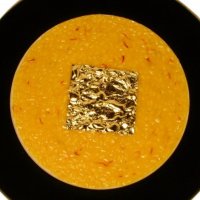The Quimbaya gold


The conqueror of the area inhabited by the Quimbaya indigenous people was Jorge Robledo, one of the lieutenants of Sebastian de Belalcazar, governor of Popayan and founder of Santiago de Cali.
In 1539 Robledo left the village of Cali, commanding a troop of about one hundred Spaniards and various indigenous slaves, and pushed north, along the Cauca river. After founding the village of Anserma, he came into contact with Cananao, the cacique of the Irras. From the latter he received a golden vase as a gift and as a sign of submission and welcome. The Spaniards instilled terror on the natives, especially for those strange shiny iron barrels that could cause death from afar, the arquebuses, but also for the iron swords and for those bizarre animals, the horses, unknown in the New World. He was told that that vase had been worked by the Quimbaya, a previously completely unknown native tribe.
Initially, however, Robledo did not immediately head to the Quimbaya territory, located further north. After crossing the Cauca he forcibly subdued some warlike tribes of Picaras, Pozos and PANCoras. So he headed decisively towards the area inhabited by the Quimbaya, corresponding to the current Colombian departments of Caldas, Risaralda, Quindìo and part of Valle del Cauca.
Robledo's entry into the Quimbaya kingdom was peaceful. The natives, who proved to be tame, did not realize that Robledo had come to conquer and misappropriate their lands and gold.
From the study of the book Noticias historiales de las conquistas de Tierra Firme en las Indias Occidentales by Friar Pedro Simon, dating back to 1626, it is clear that the Quimbayas admired Captain Robledo, and considered him a demi-god. They gave him finely crafted gold jewelry, food and bright fabrics as a sign of respect and submission. It is likely that they already knew how powerful firearms were, following the stories of other natives. In the following months, much of the Quimbaya territory was plundered and many tombs were desecrated with the aim of taking the gold jewelry. On August 9, 1540, the village of Cartago was founded. Subsequently, in 1542 there were indigenous revolts, soon suppressed in blood.
The foul raids of Quimbaya tombs brought no luck to Captain Jorge Robledo. Towards the end of 1542 he traveled to the coast of Urabà with the aim of embarking for Spain and claiming the government of the lands he had conquered and plundered. However, the governor of Cartagena Pedro de Heredia, accusing him of wanting to usurp his lands, imprisoned him and sent him to Spain to be put on trial. In Spain Robledo managed to demonstrate the groundlessness of those accusations and obtained the title of Mariscal (army judge).
On his return to the New World, he retraced the lands of the Quimbaya and the villages he founded of Anserma and Cartago. Since he claimed the governance of said lands, he came into dispute with Sebastian de Belalcazar, who, in 1546, ordered his execution. Jorge Robledo died in October 1546, killed with the terrible garrote.
In just twenty years after the arrival of the Europeans, the Quimbaya population had collapsed by 60%. The viruses transported unknowingly by the Spaniards, such as smallpox, measles, chickenpox, but also the simple flu, systematically decimated the Quimbaya, who did not have sufficient antibodies to fight the typical diseases of the old continent. During the following century all the Quimbaya became extinct or interbred with other ethnic groups. Their culture, along with their language, were lost into oblivion.
To this day very little is known about the true origin of the Quimbaya. From some documentary evidence it can be seen that the Quimbaya spoke a language of the Caribe family, and therefore it can be concluded that their ancient origin was the Amazon. How and when this migration took place remains to this day a mystery that is not easily resolved. Unfortunately, the lack of serious archaeological studies has made it difficult to reconstruct the enigma of their life and their habits and customs. Fortunately, hundreds of Quimbaya gold jewels were found and recovered, visible today at the gold museum in Santafé de Bogota, from which we can reconstruct part of their existence.
It is known that the Quimbaya culture began around 300 AD and had its classical period around the end of the first millennium AD, reaching the highest levels of quality in jewelry, perhaps not even surpassed today.
It is known that Quimbaya society was governed by caciques (the last one was Tacurumbì), who were at the political and religious summit of a group of 60,000 people.
The population was sedentary and dedicated itself to agriculture (corn, potatoes, cassava, avocado, guanabana), crafts (ceramics), the creation of cotton fabrics and clothes and jewelery (gold and gold-copper, amalgam called tumbaga ). Luckily, necklaces, pectorals, pendants, bracelets were recovered, many of them worked in a spiral, to symbolize the world of expansion and contraction, also synonymous with breathing and therefore with the breath of life, the soul. One of the most fascinating artistic pieces is the gold poporo (in the main photo), a container in which powdered stone called cal was kept, to be mixed with the coca leaf, to give the effect of removing hunger, thirst and give more strength. Usually these containers were accompanied by a long stick, also made of gold, which was used to extract the pulverized stone and bring it to the mouth.
Usually the gold poporos are decorated with female figures, sometimes in a clear state of gestation. These representations lead one to believe in a matrilineal society, where women had great importance (today the Wayuù society of northern Colombia is matriarchal). Some poporos have the upper opening divided by four perfect spheres. Some have suggested that these ornaments represent the quaternary concept of the division of the world (water, air, earth and fire) also common to many other ethnic groups.
The Quimbaya also distinguished themselves in ceramic art and created a particular style. In the northern area of their territory, monochromatic vases have been found, often black or coffee-colored. In the western region, vases painted red and decorated with abstract geometric shapes were recovered. In the lands today corresponding to the Quindìo, vases adorned with totemic symbols such as the bird (metaphor of the Sun), frogs (image of fertility), fruit (earthly or middle world), snakes (allegory of the underworld or world of darkness) have been unearthed. The double vases, joined by a kind of handle, are also very beautiful. When pouring the contained liquid, a particular sound is produced. This musical object-sound union is related to an ancient Andean tradition that seeks to connect music with the liquid element to accompany various propitiatory rituals.
There has long been debate as to whether the Quimbaya were cannibals. In reality it can be deduced from some ancient texts that before going to war the Quimbaya caciques sacrificed a slave and drank his blood, having probably devoured his flesh. These rites were very rare and had ritual value. According to their beliefs, by doing so they appropriated the power inherent in the sacrificed person and, therefore, obtained more strength.
One of the most important events in Quimbaya society was the burial of a cacique. Usually his body was buried together with gold jewelry and personal objects of the native leader. Unfortunately, the majority of the tombs were shamelessly looted by the conquistadors who eliminated the possibility of knowing more about this amazing ethnic group.
YURI LEVERATTO


























